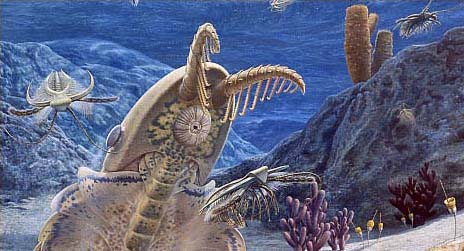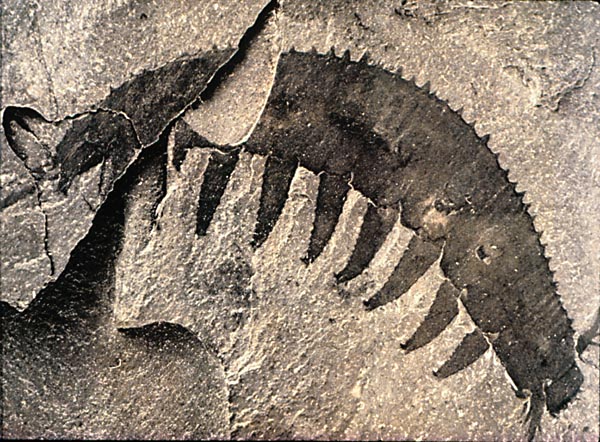 |
 |
 |
 |
 |
Produced
by the Population Genetics and Evolution class, Furman University |
||||
 |
 |
 |
 |
 |
Produced
by the Population Genetics and Evolution class, Furman University |
||||
 |
The
Cambrian: Aysheaia |
 |
||
| Aysheaia
is genus of extinct worm-like organisms that lived during the Cambrian
Period 570 to 500 mya (Smithsonian Institution 2010). Most fossilized
specimens come from either the Burgess Shale Formation of British Columbia
or the Wheeler Formation in Utah (HVNMH 2010). Members of Aysheaia
have cylindrical, segmented bodies about 1-6 cm in length, 10 pairs of
spiked limbs with claws, and a ring of 6 finger-like appendages around
their mouths as well as a set of 2 grasping appendages on their heads
(Whittington 1978). They were probably parasites that fed off sponges,
based on anatomical considerations as well as the discovery of ancient
sponge remains near many Aysheaia fossils (Smithsonian Institution
2010). They were not burrowers, and their soft bodies may have left them
vulnerable to predators such as arthropods. Researchers have speculated
that they avoided predation by living within sponge colonies. Aysheaia
is somewhat similar to both Onychophora and Tardigrada, but it is typically
classified as an onychophoran or a primitive kind of "lobopod"
organism from which the arthropods and tardigrades descended (Whittington
1978).
Page by Bob Mazgaj |
 |
| Aysheaia specimen from the Burgess Shale. Photo credit: Living Landscape | |
|
Hooper Virtual Natural Museum of History (HVMNH). 2010. Aysheaia. Accessed 30 Jan. 2010. Smithsonian Institution.2010.Burgess Shale:Aysheaia pedunculata (a velvet worm). Accessed 30 Jan. 2010. Whittington HB.1978. The Lobopod Animal Aysheaia pedunculata Walcott, Middle Cambrian, Burgess Shale, British Columbia. Phil. Trans. Roy. Soc. B. 284: 165-197. |